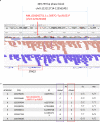Nonsense variants of STAG2 result in distinct congenital anomalies
- PMID: 33014403
- PMCID: PMC7501222
- DOI: 10.1038/s41439-020-00114-w
Nonsense variants of STAG2 result in distinct congenital anomalies
Abstract
Herein, we report two female cases with novel nonsense mutations of STAG2 at Xq25, encoding stromal antigen 2, a component of the cohesion complex. Exome analysis identified c.3097 C>T, p.(Arg1033*) in Case 1 (a fetus with multiple congenital anomalies) and c.2229 G>A, p.(Trp743*) in Case 2 (a 7-year-old girl with white matter hypoplasia and cleft palate). X inactivation was highly skewed in both cases.
Keywords: Disease genetics; Next-generation sequencing.
© The Author(s) 2020.
Conflict of interest statement
Conflict of interestThe authors declare that they have no conflict of interest.
Figures


References
LinkOut - more resources
Full Text Sources

